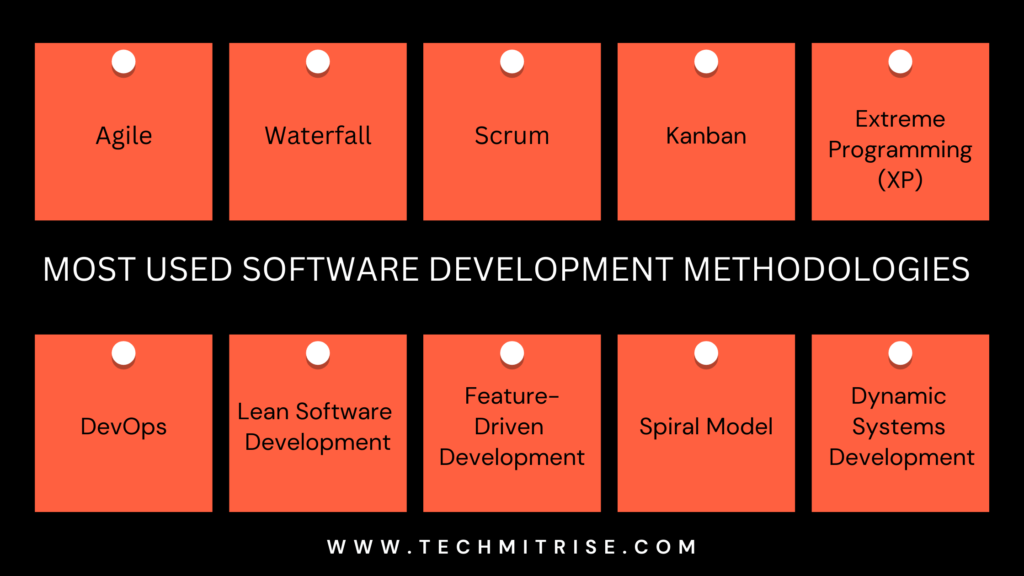In the ever-evolving world of software development, choosing the right methodology is crucial for the success of a project.
Introduction: Top Software Development Methodologies for 2024
As we approach 2024, the landscape of software development continues to evolve with a variety of methodologies that cater to different project needs and team dynamics. Here are the key methodologies that will shape the future of software development:
-
- Agile: Emphasizes flexibility, customer feedback, and continuous improvement through iterative development.
- Waterfall: A linear approach best suited for projects with well-defined requirements.
- Scrum: Structures development into sprints, fostering teamwork and iterative progress.
- Kanban: A visual workflow management method focusing on continuous delivery.
- Extreme Programming (XP): Enhances technical excellence and customer satisfaction through practices like pair programming and test-driven development (TDD).
These methodologies highlight the diverse approaches available for managing software development projects, each with its unique strengths and applications.
1. Agile
Agile is a popular iterative approach that emphasizes flexibility, customer feedback, and continuous improvement. It encourages adaptive planning and evolutionary development. Learn more at Agile Alliance.
2. Waterfall
Waterfall is a linear and sequential approach, where each phase must be completed before moving on to the next. It’s best suited for projects with well-defined requirements. For more details, visit the Project Management Institute.
3. Scrum
Scrum is a framework within Agile that structures development into sprints, typically lasting two to four weeks. It emphasizes teamwork, accountability, and iterative progress. Discover more about Scrum at the Scrum Alliance.
4. Kanban
Kanban is a visual workflow management method that uses a board to track tasks through various stages of completion. It focuses on continuous delivery without overburdening the team. Learn about Kanban at Lean Kanban University.
5. Extreme Programming (XP)
Extreme Programming (XP) is an Agile methodology focusing on technical excellence and customer satisfaction. Practices include pair programming, test-driven development (TDD), and frequent releases. Find more information at Extreme Programming.
6. DevOps
DevOps integrates development and operations to improve collaboration and productivity. It focuses on continuous delivery, automation, and monitoring to enhance software quality. Learn more from the DevOps Institute.
7. Lean Software Development
Lean applies principles from Lean manufacturing to software development, emphasizing waste reduction, continuous learning, and fast delivery of products. Explore more at the Lean Enterprise Institute.
8. Feature-Driven Development (FDD)
Feature-Driven Development (FDD) is an iterative and incremental approach to building and designing features. It includes domain modeling, feature lists, and regular builds. For further details, visit Feature-Driven Development.
9. Spiral Model
The Spiral Model combines elements of both design and prototyping in stages. It focuses on risk assessment and mitigation throughout the development process. Learn more at ResearchGate.
10. Dynamic Systems Development Method (DSDM)
DSDM is an Agile methodology emphasizing the full project lifecycle. It encourages frequent delivery, user involvement, and strict adherence to time and budget constraints. Discover more at the DSDM Consortium.

11. Joint Application Development (JAD)
JAD involves collaborative workshops where stakeholders and developers define requirements and solutions. This method enhances communication and alignment. More details can be found at TechTarget.
12. Crystal Methods
Crystal Methods is a family of Agile methodologies tailored to different team sizes and project complexities. They prioritize communication, simplicity, and frequent delivery.
13. Rational Unified Process (RUP)
Rational Unified Process (RUP) is a comprehensive framework that guides software development with a focus on iterative progress, risk management, and customizable workflows.
14. Adaptive Software Development (ASD)
Adaptive Software Development (ASD) promotes continuous adaptation to changing requirements. It emphasizes collaboration, learning, and iterative development. More information can be found at Adaptive Software Development.
15. Lean Startup
Lean Startup is geared towards startups and focuses on rapid iteration and user feedback to develop products that meet customer needs effectively. Discover more at The Lean Startup.
16. V-Model
The V-Model (Validation and Verification model) is an extension of the Waterfall model. It emphasizes the parallel relationship between development stages and corresponding testing phases.
17. Rapid Application Development (RAD)
Rapid Application Development (RAD) focuses on quick development and user feedback. It involves iterative user testing and refinement to ensure product alignment with user requirements. For more details, visit Computerworld.
18. Incremental Model
The Incremental Model divides the system into smaller segments, each developed and delivered in increments. This allows partial implementation of the system before the full system is completed.
19. Test-Driven Development (TDD)
Test-Driven Development (TDD) involves writing tests before coding. This ensures that the software meets the desired requirements and facilitates easy refactoring and maintenance.
20. Prototype Model
The Prototype Model involves creating a working prototype of the system early in the development process. This helps stakeholders understand requirements and refine system functionality. For further reading, visit IEEE.
Conclusion
Choosing the right software development methodology depends on your project’s specific needs, team dynamics, and business goals.
Each methodology offers unique advantages and potential challenges, so it’s essential to evaluate them carefully.
By understanding these methodologies, you can make informed decisions that enhance project success, improve team collaboration, and ensure the timely delivery of high-quality software products.
For more insights on software development trends, visit Top Software Development Trends for the latest articles and expert advice.



